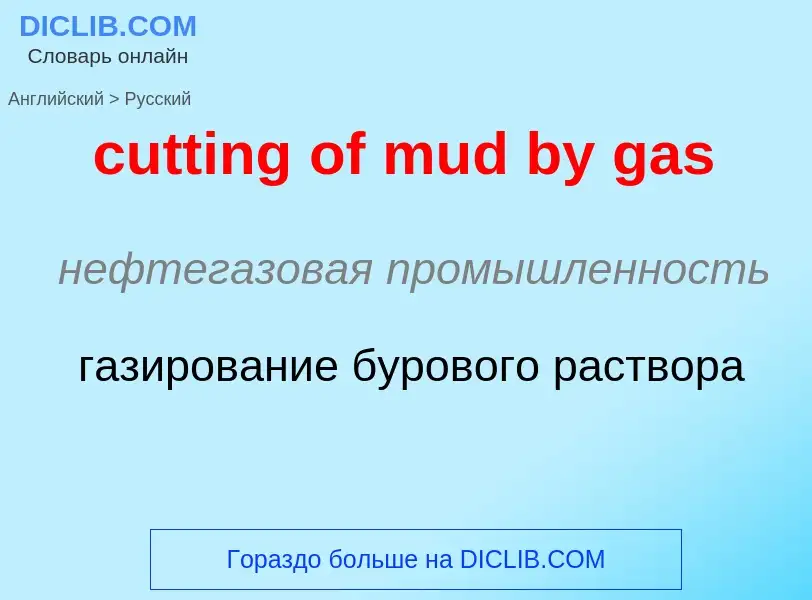Перевод и анализ слов искусственным интеллектом ChatGPT
На этой странице Вы можете получить подробный анализ слова или словосочетания, произведенный с помощью лучшей на сегодняшний день технологии искусственного интеллекта:
- как употребляется слово
- частота употребления
- используется оно чаще в устной или письменной речи
- варианты перевода слова
- примеры употребления (несколько фраз с переводом)
- этимология
cutting of mud by gas - перевод на русский
нефтегазовая промышленность
газирование бурового раствора
нефтегазовая промышленность
глинизирование, глинизация
['mʌdbɑ:θ]
медицина
грязевая ванна
грязевая аппликация
аппликация лечебной грязи
Определение
Википедия
Plasma cutting is a process that cuts through electrically conductive materials by means of an accelerated jet of hot plasma. Typical materials cut with a plasma torch include steel, stainless steel, aluminum, brass and copper, although other conductive metals may be cut as well. Plasma cutting is often used in fabrication shops, automotive repair and restoration, industrial construction, and salvage and scrapping operations. Due to the high speed and precision cuts combined with low cost, plasma cutting sees widespread use from large-scale industrial computer numerical control (CNC) applications down to small hobbyist shops.
The basic plasma cutting process involves creating an electrical channel of superheated, electrically ionized gas i.e. plasma from the plasma cutter itself, through the workpiece to be cut, thus forming a completed electric circuit back to the plasma cutter through a grounding clamp. This is accomplished by a compressed gas (oxygen, air, inert and others depending on material being cut) which is blown through a focused nozzle at high speed toward the workpiece. An electrical arc is then formed within the gas, between an electrode near or integrated into the gas nozzle and the workpiece itself. The electrical arc ionizes some of the gas, thereby creating an electrically conductive channel of plasma. As electricity from the cutter torch travels down this plasma it delivers sufficient heat to melt through the workpiece. At the same time, much of the high-velocity plasma and compressed gas blow the hot molten metal away, thereby separating, i.e. cutting through, the workpiece.
Plasma cutting is an effective way of cutting thin and thick materials alike. Hand-held torches can usually cut up to 38 mm (1.5 in) thick steel plate, and stronger computer-controlled torches can cut steel up to 150 mm (6 in) thick. Since plasma cutters produce a very hot and very localized "cone" to cut with, they are extremely useful for cutting sheet metal in curved or angled shapes.
The arcs are generated in a three step process. A high voltage spark briefly ionizes the air within the torch head. This makes the air conductive and allows the "pilot arc" to form. The pilot arc forms within the torch head, with current flowing from the electrode to the nozzle inside the torch head. The pilot arc burns up the nozzle, a consumable part, while in this phase. The air then blows the plasma out the nozzle towards the work, providing a current path from the electrode to the work. When the control system senses current flowing from the electrode to the work, it cuts the electrical connection to the nozzle. Current then flows from the electrode to the work, and the arc forms outside the nozzle. Cutting can then proceed, without burning up the nozzle. Nozzle life is limited by the number of arc starts, not cutting time.

![[[Land Rover Series III]] crawling out from a muddy hole [[Land Rover Series III]] crawling out from a muddy hole](https://commons.wikimedia.org/wiki/Special:FilePath/Land Rover Series III mud bogging.jpg?width=200)
![A [[light truck]] bogged in mud in [[Pennsylvania]] A [[light truck]] bogged in mud in [[Pennsylvania]]](https://commons.wikimedia.org/wiki/Special:FilePath/MudBoggingSeptember2007(cropped).jpg?width=200)
![Unimog U1600]] Unimog U1600]]](https://commons.wikimedia.org/wiki/Special:FilePath/Unimog U1600.jpg?width=200)

![Bather covered with mud at the [[Dead Sea]] Bather covered with mud at the [[Dead Sea]]](https://commons.wikimedia.org/wiki/Special:FilePath/Dead Sea mud man by David Shankbone.jpg?width=200)
